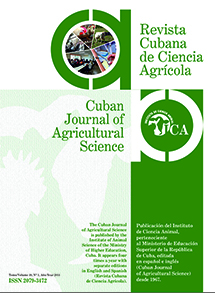Production of lignocellulases enzymes from Trichoderma viride M5-2 in wheat bran (Triticum aestivum) and purification of their laccases
Contenido principal del artículo
Resumen
The present study describes the production of lignocellulases enzymes from Trichoderma viride M5-2 in wheat bran (Triticum aestivum) and the purification of their laccases. Fermentation process was determined in wheat bran during 7 days and samples were taken every 24h. The enzymatic assay (endo, exo β1, 4-glucanase, xylanases and laccases) was performed. Laccase activity was determined with a spectrophotometer, by syringaldazine oxidation under aerobic conditions and lignin peroxidase was determined by oxidative dimerization dependent on H2O2 of 2.4-dichlorophenol. The enzyme crude was concentrated by membrane filtration with nitrogen stream and purified by ion exchange chromatography with DEAE matrix. Enzyme yield and purification parameters were measured. With the fermentation conditions in wheat bran, a sustained increase in the production of endo β1,4 glucanase and xylanases was obtained after 72 h and exo β1, 4 glucanase at 48 h and laccase enzymatic activity was checked at 24 h and lignin peroxidase
after 48h of fermentation. The fungus T. viride M5-2 reached its maximum production of laccases after two days of fermentation and through the proposed purification system, an enzymatic product with a purification factor of 12 was obtained, without affecting the enzyme yield. It is concluded that the T viride strain has the capacity to produce the lignocellulolytic enzyme complex in wheat bran. The separation method used to purify laccase enzymes is effective. It is recommended to add successive steps of purification depending on the degree of purity.
Key words: ligninase, fungi, lignin, cellulases, xylanases
after 48h of fermentation. The fungus T. viride M5-2 reached its maximum production of laccases after two days of fermentation and through the proposed purification system, an enzymatic product with a purification factor of 12 was obtained, without affecting the enzyme yield. It is concluded that the T viride strain has the capacity to produce the lignocellulolytic enzyme complex in wheat bran. The separation method used to purify laccase enzymes is effective. It is recommended to add successive steps of purification depending on the degree of purity.
Key words: ligninase, fungi, lignin, cellulases, xylanases
Detalles del artículo
Cómo citar
Valiño, E., Alberto, M., Dustet, J. C., & Albelo, N. (2020). Production of lignocellulases enzymes from Trichoderma viride M5-2 in wheat bran (Triticum aestivum) and purification of their laccases. Cuban Journal of Agricultural Science, 54(1). Recuperado a partir de https://mail.cjascience.com/index.php/CJAS/article/view/946
Sección
Ciencia Animal
Aquellos autores/as que tengan publicaciones con esta revista, aceptan los términos siguientes:
- Los autores/as conservarán sus derechos de autor y garantizarán a la revista el derecho de primera publicación de su obra, el cuál estará simultáneamente sujeto a la Licencia Creative Commons Attribution-NonCommercial 4.0 International (CC BY-NC 4.0) que permite a terceros compartir la obra siempre que se indique su autor y su primera publicación esta revista. Bajo esta licencia el autor será libre de:
- Compartir — copiar y redistribuir el material en cualquier medio o formato
- Adaptar — remezclar, transformar y crear a partir del material
- El licenciador no puede revocar estas libertades mientras cumpla con los términos de la licencia
Bajo las siguientes condiciones:
- Reconocimiento — Debe reconocer adecuadamente la autoría, proporcionar un enlace a la licencia e indicar si se han realizado cambios. Puede hacerlo de cualquier manera razonable, pero no de una manera que sugiera que tiene el apoyo del licenciador o lo recibe por el uso que hace.
- NoComercial — No puede utilizar el material para una finalidad comercial.
- No hay restricciones adicionales — No puede aplicar términos legales o medidas tecnológicas que legalmente restrinjan realizar aquello que la licencia permite.
- Los autores/as podrán adoptar otros acuerdos de licencia no exclusiva de distribución de la versión de la obra publicada (p. ej.: depositarla en un archivo telemático institucional o publicarla en un volumen monográfico) siempre que se indique la publicación inicial en esta revista.
- Se permite y recomienda a los autores/as difundir su obra a través de Internet (p. ej.: en archivos telemáticos institucionales o en su página web) antes y durante el proceso de envío, lo cual puede producir intercambios interesantes y aumentar las citas de la obra publicada. (Véase El efecto del acceso abierto).
